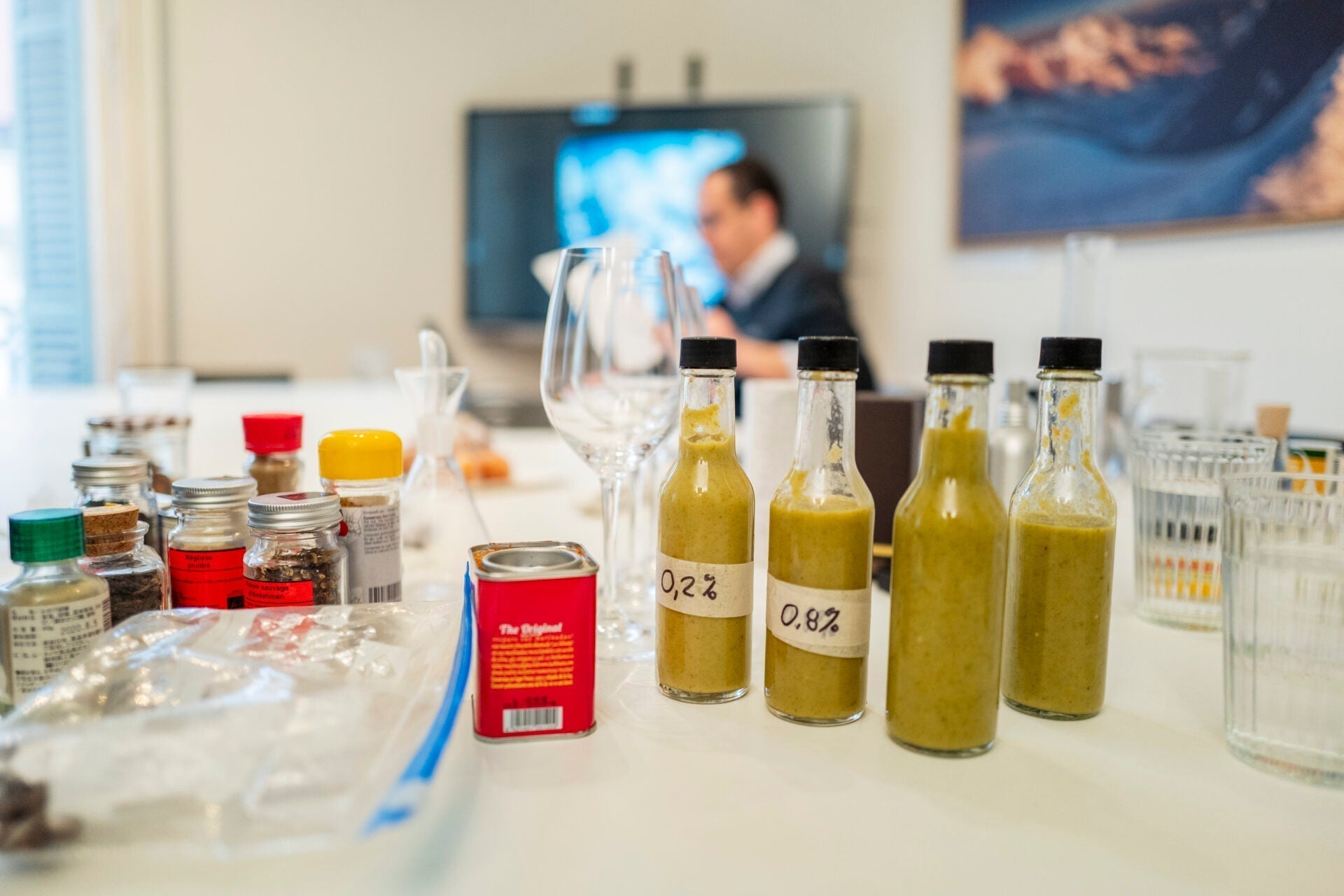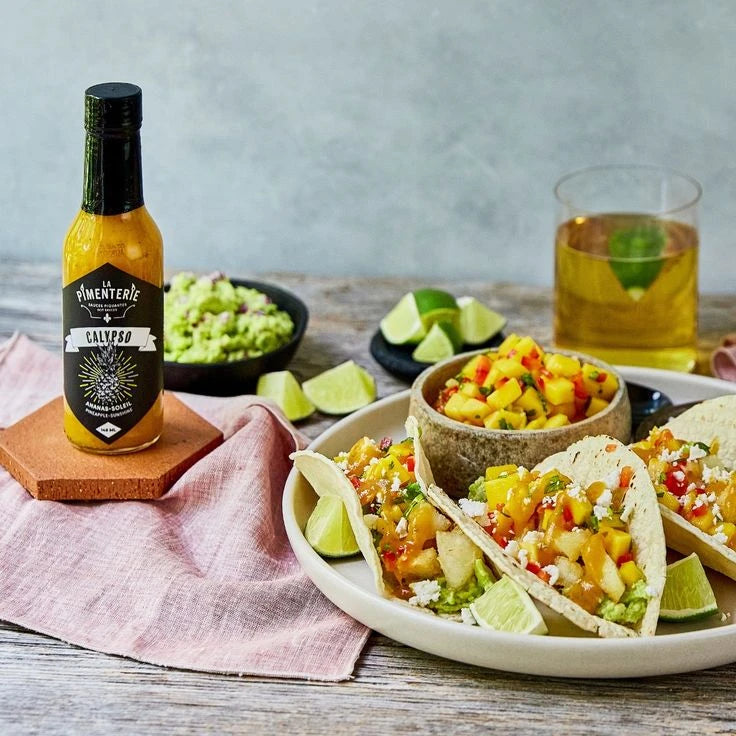Antipode: When the Science of Aromas Meets Spicy Craftsmanship
If you've been following us since the beginning of this adventure, you know that here at La Pimenterie, we're not afraid of a little heat (neither on our eyes nor our taste buds!). After telling you how the curiosity of François Chartier, world-renowned sommelier and master of molecular harmonies, was piqued by our universe, it's time to take you into the heart of the action. How do we go from a spark, an intuition, to a signature collection? Hold on tight, we're taking you behind the scenes of the creation of Antipode, a project that, as its name suggests, explores taste territories at opposite extremes.
Antipode: Genesis of a Spicy Collaboration with François Chartier
Remember? The wild idea was launched: to create the world's most gastronomic hot sauce with François Chartier. A challenge worthy of the man who revolutionized the world of sommeliers with his aromatic science. From Barcelona, François and we, from our workshop in Montreal, began to exchange ideas. The goal? Not just to create a sauce that's hot, but a true sensory experience, a culinary adventure.
The starting point of our exploration was the choice of pepper. I had proposed three candidates: the intense and deep Chocolate Habanero; the floral and fragrant Yellow Scotch Bonnet; and finally, the Aji Lemon. The latter, with its vibrant yellow color and citrus notes, particularly caught François's attention. "We went looking for dominant molecules," François explains. "Aji Lemon: limonene. A molecule that has a cold taste."
A molecule with a cold taste? Fascinating, isn't it? Limonene, present in the Aji Lemon, stimulates the freshness receptors in the mouth, much like mint. The idea immediately sparked in François's mind: "A hot sauce that makes you feel cold. There you have it, a grand clash between hot and cold!" It was bold, unexpected, and terribly exciting. The Antipode concept was born. A name that evokes this duality, this meeting of extremes.
The Aji Lemon: A Peruvian Treasure at the Heart of the Antipode Project
The Aji Lemon (Capsicum baccatum), also known as the "Lemon Drop pepper," originates from Peru. It's not a pepper you find on every street corner. Its relative rarity and unique aromatic profile make it a choice raw material for original creations. At La Pimenterie, we are fortunate to collaborate with passionate growers. The ones used for Antipode were grown just a few kilometers from our facility, on the roof of the Palais des Congrès de Montréal! It's hard to get more local and fresh than that.
This bright yellow pepper, once ripe, releases intense citrus aromas, reminiscent of lemon or even yuzu, as François points out. But it's when you taste it fresh that it reveals all its complexity. "When it's fresh, there's juice in there! It's juicy," I exclaimed while tasting it with François. There's this fresh, almost cold attack, before the controlled heat sets in. A vibrant and surprising tension. "Before the heat arrives, it's cold," François confirms. "That's why I said it tastes cold at first: it has molecules with a cold taste. That's what got me."
Key takeaway: The Aji Lemon, with its citrus notes and the limonene molecule, is the cornerstone of Antipode's "hot-cold" concept. It is the unique signature of this pepper that inspired a gustatory exploration to the frontiers of the known, a true taste journey.

Antipode Creation N°1: The Quest for a Spicy Freshness (The Green Sauce)
Armed with this discovery, we embarked on the development of the first Antipode creation, the one that would embody this famous "hot-cold" concept. François provided me with a list of about twenty ingredients that share similar "cold" aromatic molecules with the Aji Lemon: cucumber, green apple, fennel, ginger, galangal, kaffir lime leaves, lemongrass, fresh cilantro, mint, shiso, tarragon... A true playground for a taste artisan!
In our Montreal workshop, the experimentation process began. It wasn't just about mixing ingredients, but understanding how their components would interact, how their essences would blend to create an aromatic synergy. The goal was to achieve a long finish, a persistence of flavors, and of course, that perfect balance between the controlled heat of the pepper and the freshness of the other raw materials.
We tested different approaches. For example, with the cucumber, should we ferment it or prepare it as a "pickle"? Each choice had a significant impact on the final texture and aromatic profile. Then came the work on fresh herbs. We isolated three main paths: mint, shiso (a Japanese herb with complex notes, between mint, basil, and cumin), and tarragon. Each brought a different nuance, magnifying certain aspects of the sauce. "You have the apple, you have the pepper, the cucumber comes after," François noted while tasting the first trials. The addition of tarragon, for example, proved particularly interesting, bringing an elegant aniseed touch. "So it's about how what you add can magnify, but not the whole. Separately," François analyzed. That's the whole art of blending: finding the perfect harmony where each note plays its part without being out of tune.
In the end, after numerous trials, adjustments, and passionate tastings, the green sauce took shape. A creation with a balanced tension, where the spicy attack of the Aji Lemon is quickly enveloped by a surprising wave of freshness, leaving a complex and herbaceous trail. A true gastronomic discovery. "1 + 1 = 3. You've just put your finger on aromatic synergy," François enthused.
Pro tip: To appreciate the complexity of a creation like Antipode, do as the experts do! Pour a small amount of sauce into a wine glass. Swirl it gently to release the complex aromas. Inhale the essences that escape before tasting. You will discover unsuspected nuances and breadth, far beyond simple heat. It's a trick François Chartier uses to break down aromatic profiles, even those of oysters!
Antipode Creation N°2: The Subtle Balance of a Numbing Heat (The Red Sauce)
With a first creation so bold, the second had to be just as impressive, while exploring another facet of the Antipode universe. The idea for the red sauce was to work with a blend of fermented peppers, adding a unique textural and sensory dimension: a slight numbing effect, brought by a combination of different peppers, including the famous Quebec clavalier (the local equivalent of Sichuan pepper) and Japanese sansho.
For this development, we explored ingredients like koji (a yellow pea ferment bringing a deep umami note) and hemp, for its texture and earthy notes. The challenge was to create a sauce with a controlled but present heat, a deep aromatic complexity, and that famous "numbing" sensation that doesn't mask the flavors, but enhances them.
The first trials were promising, but a logistical setback threw a wrench in our plans: the samples I had sent to François in Barcelona got lost in transit! No matter, not wanting to delay our creative momentum, I hopped on a plane, samples in hand, heading for Catalonia. François had to taste these new bases.
In Barcelona, we tasted the different versions: plain, with hemp, with extra peppers, and a mix of the two. The fresh clavalier, which we use once harvested and frozen to preserve its green and vibrant aromas, particularly impressed François. "I didn't know the name clavalier, but I had never tasted it," he admitted. "I find it very interesting." The verdict fell on the blend with hemp and the trio of peppers: "Better attack, more fruity on the attack, more acidity, more vibrant. More pepper. More spicy, more piquant, more peppery," François analyzed. "The citrusy side of Sichuan, it has aspects that are deeply aromatic, lemongrass, fresh cilantro, it makes you salivate. It's very long in the mouth. We like that. I really like that. The dosage is much better here." The Antipode red sauce had found its signature.

Antipode Put to the Test... by the Expert Palates of Barcelona
With two such accomplished creations, François, true to his commitment to excellence, wanted to test them against other expert palates. And not just any palates: those of great Michelin-starred chefs in Barcelona, some of whom were alumni of the mecca of molecular gastronomy, El Bulli. A real test for our Antipode sauces, which aimed to enhance dishes and be part of a gastronomic spicy approach.
The reactions were unanimous regarding the originality and quality of the sauces. Regarding the green sauce: "I don't relate it to hot sauce, obviously. It could be more of an addition before a hot sauce," commented one chef, highlighting its unique character. Another, a former head chef at El Bulli, noted: "The hot sauce is unique. Tarragon... spicy, huh? The fennel... It's hot at the end! And at the beginning. Yes. But at the beginning, it's a hot sauce." The freshness, acidity, balanced heat, and long finish were all praised.
The red sauce, with its blend of peppers, also impressed. "It's more complex because there are nuances of freshness, nuances of anise, hints of... It's not smoky, but it's... that roasted quality. Toasted," analyzed one of the chefs. The idea of even being able to mix the two sauces to create one's own experience was appealing: "What's good is that if you don't mix things and the customer can do it, you can offer more of this and less of that. Or more of that and less of this. Everyone can do it as they wish," concluded a visionary chef.
This feedback was a tremendous validation of our approach. It confirmed that our quest for an artisanal hot sauce, capable of competing with the great condiments of gastronomy, was not just a pipe dream. The Antipode culinary adventure was taking on an international dimension.
More Than Sauces: The Birth of the Antipode Identity
With the recipes refined and validated by the best, a new, equally crucial stage opened up for us: giving a name and a visual identity to these two creations. The name "Antipode" had imposed itself as an obvious choice, embodying this play of contrasts, this journey between Montreal and Barcelona, between hot and cold, between the tradition of handmade and the innovation of aromatic science.
Now we needed a design that reflected this vision, something that embodied the brilliance, the nuances, and the balance of these sauces. A process that requires time, patience, and deep reflection on the impression we wanted to leave.











0 comments